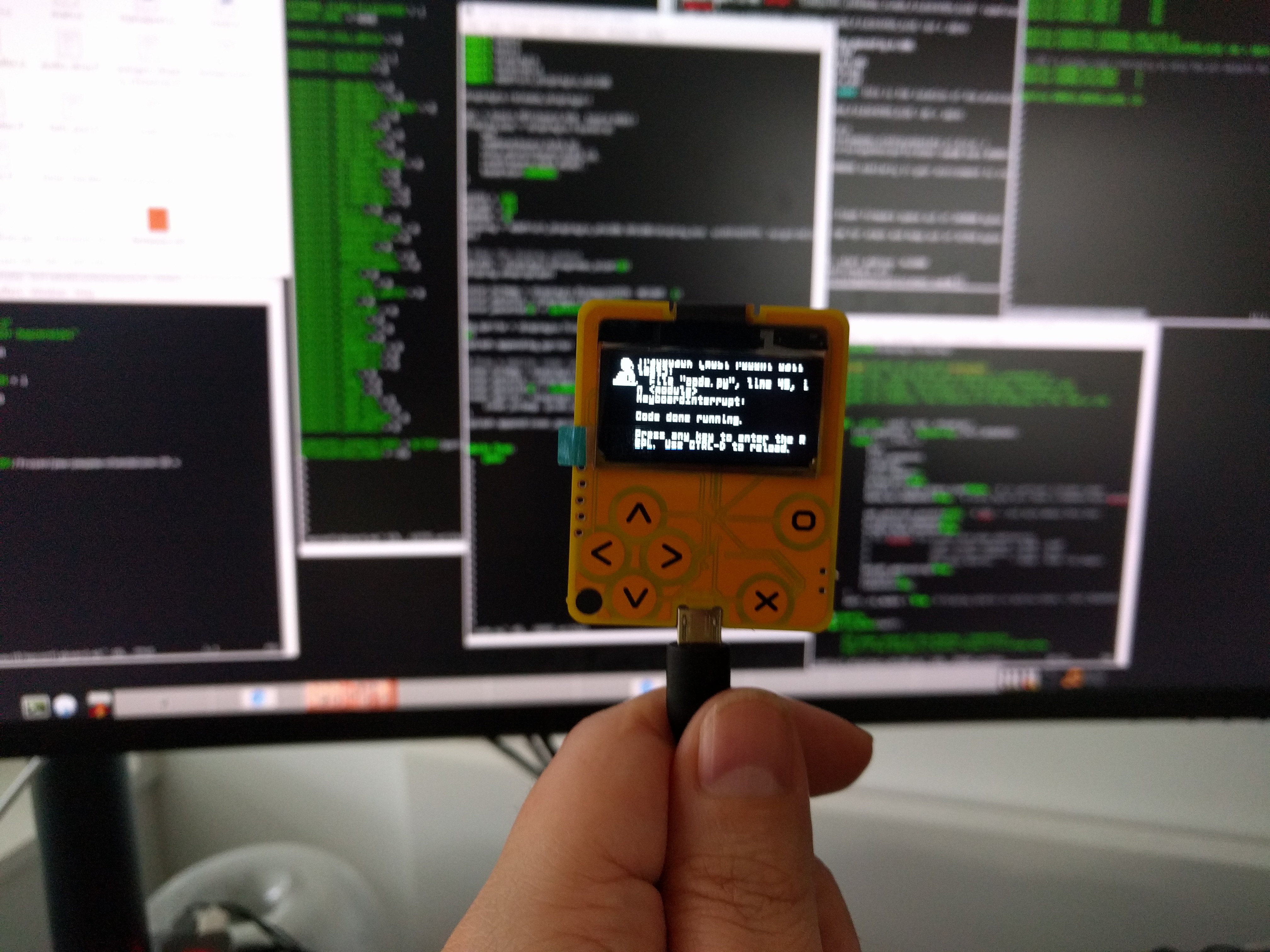Last time I went all the way up to flashing an UF2 bootloader on the SAMD21 chip, now we need to get CircuitPython running on it. Normally I would just use the firmware for #Fluff M0 — it has all the pins available, so it's very convenient for such things, but this time we are going to need the displayio module compiled into the firmware, and later we will also add the display initialization, so that the display just works as soon as the device is switched on, without us having to initialize it in our own code.
To add a new SAMD board, the easiest way is to copy an existing board definition, like the fluff_m0 one, in ports/atmel-samd/boards, and rename it. Then we can edit the files to make our changes:
mpconfigboard.h
#define MICROPY_HW_BOARD_NAME "PewPew OLED"
#define MICROPY_HW_MCU_NAME "samd21e18"
#define MICROPY_PORT_A (0)
#define MICROPY_PORT_B (0)
#define MICROPY_PORT_C (0)
#define CIRCUITPY_INTERNAL_NVM_SIZE 0
#define CIRCUITPY_INTERNAL_FLASH_FILESYSTEM_SIZE (48 * 1024)
// USB is always used internally so skip the pin objects for it.
#define IGNORE_PIN_PA24 1
#define IGNORE_PIN_PA25 1
#define SAMD21_BOD33_LEVEL (6)There are three noteworthy things here. We change the NVM size to 0 (this is a part of the flash reserved for storing additional information, we are not going to be using that), and the filesystem size to 48kB (from the default of 64kB). This is needed to make more room for the firmware in the flash, because we want to include displayio, which is quite big.
Finally, the SAMD21_BOD33_LEVEL variable controls the brown-out detection voltage level. We need to set it as low as practical, so that our device can work from a puny 3V battery without going into safe mode.
Later on we can add all the pins we are not using on the device, to save some RAM. It's not important right now.
pins.c
#include "shared-bindings/board/__init__.h"
STATIC const mp_rom_map_elem_t board_global_dict_table[] = {
{ MP_ROM_QSTR(MP_QSTR_SCK), MP_ROM_PTR(&pin_PA09) },
{ MP_ROM_QSTR(MP_QSTR_MOSI), MP_ROM_PTR(&pin_PA08) },
{ MP_ROM_QSTR(MP_QSTR_OLED_DC), MP_ROM_PTR(&pin_PA10) },
{ MP_ROM_QSTR(MP_QSTR_OLED_CS), MP_ROM_PTR(&pin_PA01) },
{ MP_ROM_QSTR(MP_QSTR_OLED_RESET), MP_ROM_PTR(&pin_PA00) },
{ MP_ROM_QSTR(MP_QSTR_TOUCH_UP), MP_ROM_PTR(&pin_PA02) },
{ MP_ROM_QSTR(MP_QSTR_TOUCH_DOWN), MP_ROM_PTR(&pin_PA05) },
{ MP_ROM_QSTR(MP_QSTR_TOUCH_LEFT), MP_ROM_PTR(&pin_PA03) },
{ MP_ROM_QSTR(MP_QSTR_TOUCH_RIGHT), MP_ROM_PTR(&pin_PA04) },
{ MP_ROM_QSTR(MP_QSTR_TOUCH_O), MP_ROM_PTR(&pin_PA06) },
{ MP_ROM_QSTR(MP_QSTR_TOUCH_X), MP_ROM_PTR(&pin_PA07) },
};
MP_DEFINE_CONST_DICT(board_module_globals, board_global_dict_table);This defines which pins on the microcontroller are used for what.
mpconfigboard.mk
USB_VID = 0x239A
USB_PID = 0x80B0
USB_PRODUCT = "PewPew OLED"
USB_MANUFACTURER = "Radomir Dopieralski"
CHIP_VARIANT = SAMD21E18A
CHIP_FAMILY = samd21
INTERNAL_FLASH_FILESYSTEM = 1
LONGINT_IMPL = NONE
CIRCUITPY_FULL_BUILD = 0
CIRCUITPY_DISPLAYIO = 1
CIRCUITPY_TOUCHIO = 1
CIRCUITPY_ANALOGIO = 0
CIRCUITPY_AUDIOBUSIO = 0
CIRCUITPY_AUDIOBUSIO_I2SOUT = 0
CIRCUITPY_AUDIOCORE = 0
CIRCUITPY_AUDIOIO = 0
CIRCUITPY_AUDIOMIXER = 0
CIRCUITPY_AUDIOMP3 = 0
CIRCUITPY_AUDIOPWMIO = 0
CIRCUITPY_BITBANG_APA102 = 0
CIRCUITPY_BITBANGIO = 0
CIRCUITPY_BITBANGIO = 0
CIRCUITPY_BITMAPTOOLS = 0
CIRCUITPY_BITMAPTOOLS = 0
CIRCUITPY_BLEIO = 0
CIRCUITPY_BUSDEVICE = 0
CIRCUITPY_FRAMEBUFFERIO = 0
CIRCUITPY_FREQUENCYIO = 0
CIRCUITPY_GAMEPAD = 0
CIRCUITPY_GAMEPADSHIFT = 0
CIRCUITPY_I2CPERIPHERAL = 0
CIRCUITPY_MATH = 0
CIRCUITPY_MSGPACK = 0
CIRCUITPY_NEOPIXEL_WRITE = 0
CIRCUITPY_NVM = 0
CIRCUITPY_PIXELBUF = 0
CIRCUITPY_PS2IO = 0
CIRCUITPY_PULSEIO = 0
CIRCUITPY_PWMIO = 0
CIRCUITPY_RGBMATRIX = 0
CIRCUITPY_ROTARYIO = 0
CIRCUITPY_ROTARYIO = 0
CIRCUITPY_RTC = 0
CIRCUITPY_SAMD = 0
CIRCUITPY_ULAB = 0
CIRCUITPY_USB_HID = 0
CIRCUITPY_USB_MIDI = 0
CIRCUITPY_USB_VENDOR = 0
CIRCUITPY_VECTORIO = 0
CIRCUITPY_DISPLAY_FONT = $(TOP)/ports/atmel-samd/boards/ugame10/brutalist-6.bdf
OPTIMIZATION_FLAGS = -OsYou can see a looooong list of disabled modules here. That's because I was trying to reclaim as much space as possible for displayio, before I gave up and simply shrunk the filesystem. There is also a custom tiny font. For now I'm using the same VID/PID as the fluff_m0, I will need to ask for unique ones when I will be adding that board to CircuitPython repository.
And that's it, the board.c file is not needed for us right now — we will use it for display initialization later on, though.
Next, I just looked for an SH1106 display driver for CircuitPython and displayio on the Adafruit Github, compiled the new board, and we have a working device:

 deʃhipu
deʃhipu
Discussions
Become a Hackaday.io Member
Create an account to leave a comment. Already have an account? Log In.